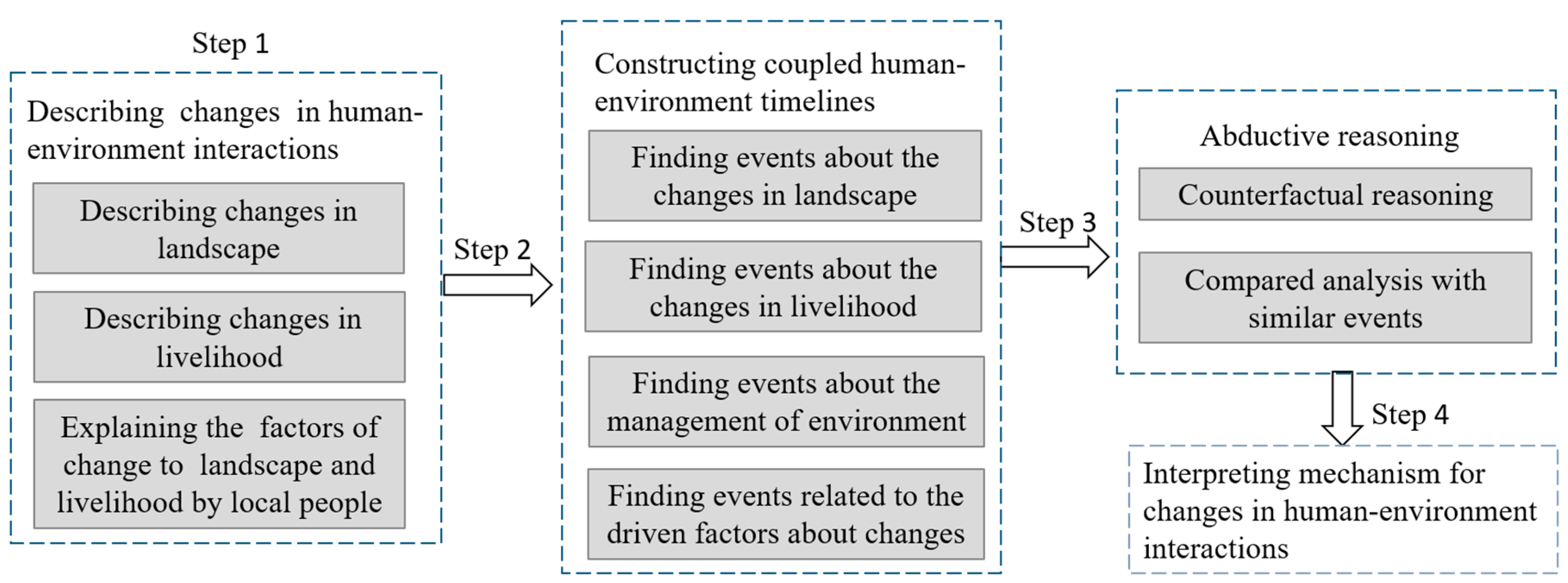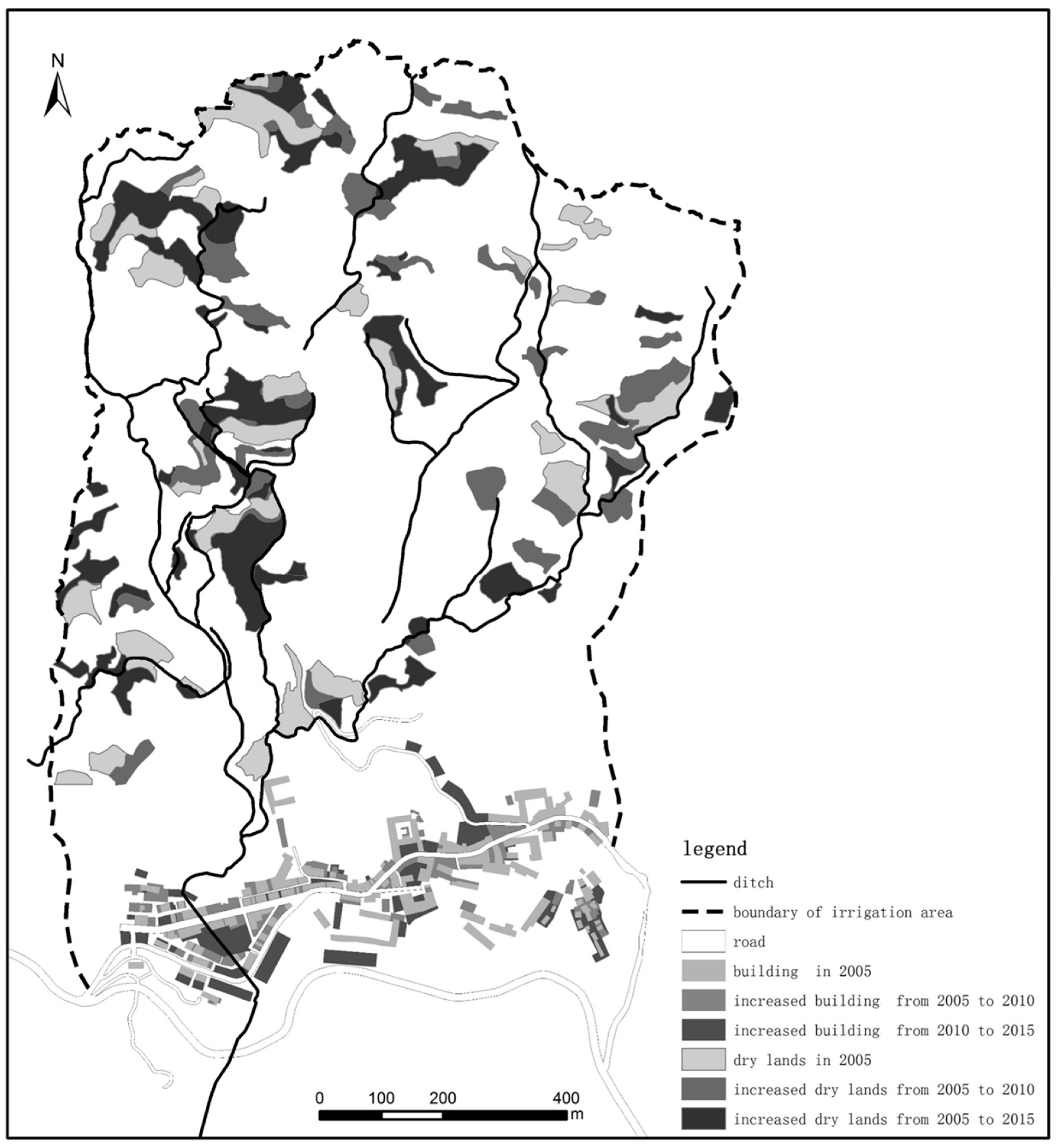The Change Mechanism of Human-Environment Interactions from the Perspective of Contextualization: A Case Study of the Honghe Hani Rice Terraces as a World Cultural Heritage Site
Abstract
1. Introduction
2. Theoretical Basis and Research Framework
2.1. Event Ecology
2.2. Research Framework for Human-Environment Interactions Based on Event Ecology
2.2.1. The Methods in Event Ecology
2.2.2. Research Framework
3. Study Area and Information Collection
3.1. Study Area
3.2. Information Collection
4. Results
4.1. Changes in Landscape and Means of Livelihood
4.2. Causes of the Changes in Landscape and Residents’ Means of Livelihood
4.3. Causal Historical Analysis for Changes in Landscape and Human-Environment Interaction
4.4. Abductive Reasoning and the Results
5. Discussion and Conclusions
Author Contributions
Funding
Acknowledgments
Conflicts of Interest
References
- Harden, C.P. Framing and Reframing Questions of Human–environment Interactions. Ann. Assoc. Am. Geogr. 2012, 102, 737–747. [Google Scholar] [CrossRef]
- Moran, E.F.; Lopez, M.C. Future Directions in Human-environment Research. Environ. Res. 2016, 144, 1–7. [Google Scholar] [CrossRef] [PubMed]
- Young, O.R.; Lambin, E.F.; Alcock, F.; Haberl, H.; Karlsson, S.I.; McConnell, W.J.; Myint, T.; Pahl-Wostl, C.; Polsky, C.; Ramakrishnan, P.S. A Portfolio Approach to Analyzing Complex Human-environment Interactions: Institutions and Land Change. Ecol. Soc. 2006, 2, 31. Available online: http://www.ecologyandsociety.org/vol11/iss2/art31/ (accessed on 3 May 2017). [CrossRef]
- Judkins, G.; Smith, M.; Keys, E. Determinism Within Human-environment Research and the Rediscovery of Environmental Causation. Geogr. J. 2008, 174, 17–29. [Google Scholar] [CrossRef]
- Vayda, A.P. Progressive Contextualization: Methods for Research in Human Ecology. Hum. Ecol. 1983, 11, 265–281. [Google Scholar] [CrossRef]
- Walters, B.B.; Vayda, A.P. Event Ecology, Causal Historical Analysis, and Human-environment Research. Ann. Assoc. Am. Geogr. 2009, 99, 534–553. [Google Scholar] [CrossRef]
- Epstein, G.; Vogt, J.; Mincey, S.; Cox, M.; Fischer, B. Missing Ecology: Integrating Ecological Perspectives with the Social-ecological System Framework. Int. J. Commons 2013, 7, 432–453. [Google Scholar] [CrossRef]
- Vogt, J.M.; Epstein, G.B.; Mincey, S.K.; Burnell, C.; McCord, P. Putting the “E” in SES: Unpacking the Ecology in the Ostrom Social-ecological System Framework. Ecol. Soc. 2015, 20, 55. [Google Scholar] [CrossRef]
- Buttimer, A. Diverse Perspectives on Society and Environment—Plenary Lecture at the 32th International Geographical Congress. Prog. Geogr. 2013, 32, 323–340. [Google Scholar]
- Buttimer, A. Geography and the Human Spirit; Johns Hopkins University Press: Baltimore, MA, USA, 1993; pp. 11–35. ISBN 0-8018-4338-3. [Google Scholar]
- Aplin, G. World Heritage Cultural Landscapes. Int. J. Herit. Stud. 2007, 13, 427–446. [Google Scholar] [CrossRef]
- Akagawa, N.; Sirisrisak, T. Cultural Landscapes in Asia and the Pacific: Implications of the World Heritage Convention. Int. J. Herit. Stud. 2008, 14, 176–191. [Google Scholar] [CrossRef]
- Mananghaya, J.B. Heritage, Driver for Development and the Case of the Rice Terraces of the Philippine cordilleras. In Proceedings of the ICOMOS 17th General Assembly, Paris, France, 27 November–2 December 2011. [Google Scholar]
- Calderon, M.M.; Dizon, J.T.; Bantayan, N.C.; Sajise, A.J.U.; Codilan, A.L.; Salvador, M.G. Payments for Environmental and Cultural Services and the Conservation of the Ifugao Rice Terraces. Available online: https://www.researchgate.net/publication/265198476 (accessed on 2 June 2017).
- Bantayan, N.C.; Calderon, M.M.; Dizon, J.T. Estimating the Extent and Damage of the UNESCO World Heritage Sites of the Ifugao. J. Environ. Sci. Manag. 2012, 15, 459–481. [Google Scholar]
- UNESCO. Cultural Landscapes: The Challenges of Conservation. 2002. Available online: http://whc.unesco.org/venice2002 (accessed on 30 May 2015).
- Guimbatan, R.; Baguilat, T. Misunderstanding the Notion of Conservation in the Philippine Rice Terraces–Cultural Landscapes. Int. Soc. Sci. J. 2006, 58, 59–67. [Google Scholar] [CrossRef]
- Jiao, Y.; Li, X.; Liang, L.; Takeuchi, K.; Okuro, T.; Zhang, D.; Sun, L. Indigenous Ecological Knowledge and Natural Resource Management in the Cultural Landscape of China’s Hani Terraces. Ecol. Res. 2012, 27, 247–263. [Google Scholar] [CrossRef]
- Yuan, Z.; Lun, F.; He, L.; Cao, Z.; Min, Q.; Bai, Y.; Liu, M.C.; Cheng, S.K.; Li, W.H.; Fuller, A.M. Exploring the State of Retention of Traditional Ecological Knowledge in a Hani Rice Terrace Village, Southwest China. Sustainability 2014, 6, 4497–4513. [Google Scholar] [CrossRef]
- Walters, B.B. Human Ecological Questions for Tropical Restoration: Experiences from Planting Native Upland Trees and Mangroves in the Philippines. Forest Ecol. Manag. 1997, 99, 275–290. [Google Scholar] [CrossRef]
- Walters, B.B. People and mangroves in the Philippines: Fifty years of coastal environmental change. Environ. Conserv. 2003, 30, 293–303. [Google Scholar] [CrossRef]
- Walters, B.B. Ecological Effects of Small-scale Cutting of Philippine Mangrove Forests. Forest Ecol. Manag. 2005, 206, 331–348. [Google Scholar] [CrossRef]
- Walters, B.B. Local Management of Mangrove Forests in the Philippines: Successful Conservation or Efficient Resource Exploitation? Hum. Ecol. 2004, 32, 177–195. [Google Scholar] [CrossRef]
- Walters, B.B. Local Mangrove Planting in the Philippines: Are Fisherfolk and Fishpond Owners Effective Restorationists? Restor. Ecol. 2000, 8, 237–246. [Google Scholar] [CrossRef]
- Walters, B.B. An Event-based Methodology for Climate Change and Human-environment Research. Geogr. Tidsskr.-Dan. J. Geogr. 2012, 112, 135–143. [Google Scholar] [CrossRef]
- Vayda, A.P. Causal Explanation of Indonesian Forest Fires: Concepts, Applications, and Research Priorities. Hum. Ecol. 2006, 34, 615–635. [Google Scholar] [CrossRef]
- Walters, B.B. Events, Politics and Environmental Change. In Against the Grain: The Vayda Tradition in HumanEecology and Ecological Anthropology; Walters, B.B., Mc-Cay, B.J., West, P., Lees, S., Eds.; AltaMira Press: Lanham, MD, USA, 2008; pp. 67–79. ISBN 978-0-759-11172-1. [Google Scholar]
- Vayda, A.P. Causal Explanation as a Research Goal: A Pragmatic View. In Against the Grain: The Vayda Tradition in HumanEecology and Ecological Anthropology; Walters, B.B., Mc-Cay, B.J., West, P., Lees, S., Eds.; AltaMira Press: Lanham, MD, USA, 2008; pp. 317–367. ISBN 978-0-759-11172-1. [Google Scholar]
- Vayda, A.P.; Walters, B.B. Introduction: Pragmatic methods and causal-history explanations. In Causal Explanation for Social Scientists: A Reader; Vayda, A.P., Walters, B.B., Eds.; AltaMira Press: Lanham, MD, USA, 2011; pp. 1–21. ISBN 978-0-7591-1325-1. [Google Scholar]
- Walters, B.B. Migration, Land Use and Forest Change in St. Lucia, West Indies. Land Use Policy 2016, 51, 290–300. [Google Scholar] [CrossRef]
- Nielsen, J.Ø.; Reenberg, A. Temporality and the Problem with Singling Out Climate as a Current Driver of Change in a Small West African Village. J. Arid. Environ. 2010, 74, 464–474. [Google Scholar] [CrossRef]
- Vayda, A.P. Causal Explanation as a Research Goal: Dos and Don’ts. In Explaining Human Actions and Environment Changes; Vayda, A.P., Ed.; AltaMira Press: Lanham, MD, USA, 2009; pp. 1–47. ISBN 978-0-7591-0323-8. [Google Scholar]
- Minteer, B.A.; Corley, E.A.; Manning, R.E. Environmental Ethics Beyond Principle? The Case for a Pragmatic Contextualism. J. Agric. Environ. Ethics 2004, 17, 131–156. [Google Scholar] [CrossRef]
- Robbins, P.; Vayda, A.P.; Walters, B.B. (Eds.) Causal Explanation for Social Scientists. Hum. Ecol. 2012, 40, 657–659. [Google Scholar]
- Buttimer, A. Sustainable Development: Issues of Scale and Appropriateness. In Sustainable Landscapes and Lifeways: Scales and Appropriateness, 1st ed.; Buttimer, A., Ed.; Cork University Press: Cork, Ireland, 2001; pp. 24–28. ISBN 3-0623-1310-5. [Google Scholar]
- Buttimer, A. Landscape and Life: Appropriate Scales for Sustainable Development. Irish Geogr. 1998, 31, 1–33. [Google Scholar] [CrossRef]
- Zhu, X.Y. Black Land, Sick Land and Lost Land: The Topography of a Yunnan Village and a Critique of Scott. J. China Agric. Univ. 2008, 25, 22–48. [Google Scholar]
- Zhu, X.Y. The Forestry Tenure and the Topography: A Case Study of a Yunnan Village. J. China Agric. Univ. 2009, 26, 60–72. [Google Scholar]
- Zhu, X.Y. The Story of a Yunnan Village: Topography and Home; Peking University Press: Beijing, China, 2011; pp. 54–70. ISBN 978-7-301-18196-6. [Google Scholar]
- Reenberg, A.; Birch-Thomsen, T.; Mertz, O.; Fog, B.; Christiansen, S. Adaptation of Human Coping Strategies in a Small Island Society in the SW Pacific—50 Years of Change in the Coupled human–environment System on Bellona, Solomon Islands. Hum. Ecol. 2008, 36, 807–819. [Google Scholar] [CrossRef]
- The Bureau of Honghe Prefecture Statistics. Statistical Yearbook of Honghe Autonomous Prefecture; Yunnan Science and Technology Publishing Press: Kunming, China, 2015; pp. 15–60. ISBN 978-7-541-64191-6. [Google Scholar]
- Wang, Q.H. On the Culture of the Terraced Field; Yunnan University Press: Kunming, China, 2003; pp. 53–81. ISBN 7-81025-917-2/G·125. [Google Scholar]
- Walters, B.B.; Hansen, L. Farmed Landscapes, Trees and Forest Conservation in Saint Lucia (West Indies). Environ. Conserv. 2013, 40, 211–221. [Google Scholar] [CrossRef]
- Walters, B.B. Do Property Rights Matter for Conservation? Family Land, Forests and Trees in Saint Lucia, West Indies. Hum. Ecol. 2012, 40, 863–878. [Google Scholar] [CrossRef]
- Williams, P.W.; Ponsford, I.F. Confronting Tourism’s Environmental Paradox: Transitioning for Sustainable Tourism. Futures 2009, 41, 396–404. [Google Scholar] [CrossRef]
- Nyaupane, G.P.; Poudel, S. Linkages among Biodiversity, Livelihood, and Tourism. Anna Tour. Res. 2011, 38, 1344–1366. [Google Scholar] [CrossRef]
- Mbaiwa, J.E. Changes on Traditional Livelihood Activities and Lifestyles Caused by Tourism Development in the Okavango Delta, Botswana. Tour. Manag. 2011, 32, 1050–1060. [Google Scholar] [CrossRef]
- Smith, D.M. Explaining Human Actions and Environmental Changes. J. Ecol. Anthropol. 2010, 14, 101–102. [Google Scholar] [CrossRef]
- Vayda, A.P.; Walters, B.B. against Political Ecology. Hum. Ecol. 1999, 27, 167–179. [Google Scholar] [CrossRef]
- Walters, B.B. Explaining Rural Land Use Change and Reforestation: A Causal-Historical Approach. Land Use Policy 2017, 67, 608–624. [Google Scholar] [CrossRef]
- Robbins, P. Political Ecology: A Critical Introduction, 2nd ed.; John Wiley & Sons: Chichester, UK, 2011; pp. 46–48. ISBN 978-0-470-65732-4. [Google Scholar]




© 2018 by the authors. Licensee MDPI, Basel, Switzerland. This article is an open access article distributed under the terms and conditions of the Creative Commons Attribution (CC BY) license (http://creativecommons.org/licenses/by/4.0/).
Share and Cite
Hua, H.; Zhou, S.; Ding, Z.; Pan, Y. The Change Mechanism of Human-Environment Interactions from the Perspective of Contextualization: A Case Study of the Honghe Hani Rice Terraces as a World Cultural Heritage Site. Sustainability 2018, 10, 2230. https://doi.org/10.3390/su10072230
Hua H, Zhou S, Ding Z, Pan Y. The Change Mechanism of Human-Environment Interactions from the Perspective of Contextualization: A Case Study of the Honghe Hani Rice Terraces as a World Cultural Heritage Site. Sustainability. 2018; 10(7):2230. https://doi.org/10.3390/su10072230
Chicago/Turabian StyleHua, Honglian, Shangyi Zhou, Zhiqiang Ding, and Yujun Pan. 2018. "The Change Mechanism of Human-Environment Interactions from the Perspective of Contextualization: A Case Study of the Honghe Hani Rice Terraces as a World Cultural Heritage Site" Sustainability 10, no. 7: 2230. https://doi.org/10.3390/su10072230
APA StyleHua, H., Zhou, S., Ding, Z., & Pan, Y. (2018). The Change Mechanism of Human-Environment Interactions from the Perspective of Contextualization: A Case Study of the Honghe Hani Rice Terraces as a World Cultural Heritage Site. Sustainability, 10(7), 2230. https://doi.org/10.3390/su10072230



